This is the fourth installment in a six-part series discussing how to increase the age when trees are harvested. “Long rotations” refers to delaying logging and growing forests past a short “financial rotation age” to an older “biological rotation age” that stores more carbon, produces more timber, and improves forest health, water quality, and wildlife habitat. View the full series here.
Where timber plantations were once logged intensively on short rotations, older and more complex forests now stand on the 9,400 acres owned by the van Eck Forest Foundation in Oregon and California. The new practices store more carbon and offer ideal stream conditions for salmon as well as habitat for marbled murrelets and northern spotted owls. Legal agreements called working forest conservation easements (WFCEs) protect these forests from conversion to agriculture or development, and the van Eck easements include prescriptions that also guarantee improved forest management, including growing older trees, into the future.
In defiance of the false jobs-versus-environment dichotomy, these forests produce millions of board feet of timber each year, supporting loggers, truck drivers, mill workers, foresters, and biologists. Selling carbon credits from its California forests adds another income stream for the Van Eck Forest Foundation.
The practice of “long rotations” means growing trees longer before logging them. It extends the length of a harvest cycle from a short “financial rotation age” that maximizes net present value to a longer “biological rotation age” that maximizes timber production as well as carbon storage, habitat, and water quality.
Economists call the ecological harm of intensive short-rotation logging a market failure. That is, when the environmental benefits are accounted for, long rotations increase the wealth of society as a whole by more than enough to pay landowners to delay harvest. Of course, though, without countervailing action, such payment does not occur.
Meanwhile, timber companies do not have to pay the environmental costs of short rotations. These are often unseen “environmental externalities.” And long rotations’ ecological benefits, because they are public goods that everyone can enjoy whether or not they cut a check to the landowners and investors, suffer from a lack of adequate voluntary funding: the free rider problem. This means that timberland owners, for whom delaying harvest comes at a steep cost, can’t get paid for their work of stewarding these trees through long rotations. It’s a cycle that cheats the foresters, society, and the environment.
In ballpark figures, fixing the short-rotation market failure on the 8 million acres of private industrial forest in western Oregon and Washington would cost around $16 billion.1 That sounds steep, until one learns that it would generate around $40 billion in carbon storage benefits alone.2 That is over 100 percent return on investment.
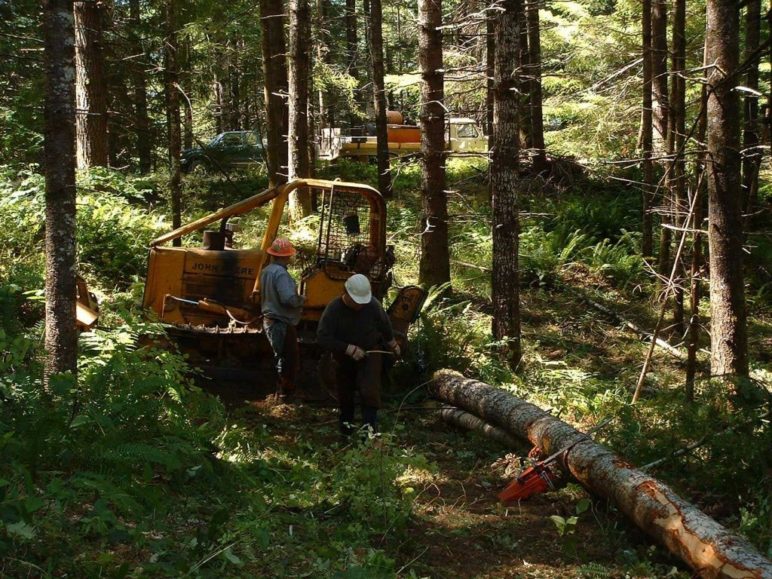
Following the terms of a working forest conservation easement (WFCE), selective logging creates a small patch opening for canopy diversity, leaving a healthy amount of older trees in the Van Eck Forests of Lincoln County, Oregon. Source: Pacific Forest Trust staff.
Is there a way to fix this market failure? Economists have traditionally recommended two kinds of solutions: regulate companies or privatize benefits. Starting with the second option, Sightline examined seven existing mechanisms that Cascadians could use to pay landowners what it costs them to grow older forests, incentivizing those landowners to do so while also supporting the ecological benefits regional residents and people around the globe so appreciate about their forestlands. While we did not perform a robust quantitative analysis that accounts for feedback and equilibrium effects, we did examine the current size and shape of these mechanisms and we compared them with both the carbon storage benefits of long rotations and their costs to landowners.
Because forest health and carbon storage are public goods that are vulnerable to free-riding, voluntary mechanisms alone—carbon markets, sustainable sourcing, sustainability certifications, and impact investing—cannot meet the scale needed to fix the short-rotation market failure. (In other words, these voluntary markets also suffer from market failure.)
The Forest Legacy Program (FLP) and the Healthy Forest Reserve Program (HFRP) could pay landowners for long rotations at the scale needed to fix the short rotation market failure.

But two existing and time-tested US federal programs could. The Forest Legacy Program (FLP) and the Healthy Forest Reserve Program (HFRP) could pay landowners for long rotations at the scale needed to fix the short rotation market failure. FLP appears to be more cost-effective than HFRP because it funds ecological working forest conservation easements (WFCEs) that ensure older forests in perpetuity. For either program to fund older forests at scale, what is required are minor modifications to their current rules and an adequate appropriations bill in Congress.
Congress likely will not pass such an appropriations bill until the widespread belief that “wood is wood” (and that “it’s all renewable so it’s all good”) is replaced with an understanding of the climate and ecological benefits of older forests. Nearly all ways of paying for long rotations can promote this shift. For example, even though it may not sufficiently scale, sustainable wood sourcing policies may be the most effective of the tools that Sightline examined at spreading sustainable wood literacy among the general public, builders, engineers, mill personnel, and foresters. Consciousness-raising is one way that these seven mechanisms to pay for long rotations are more complementary and synergistic than simply additive.
1. Fund ecological working forest conservation easements (WFCEs)
When it comes to storing carbon in forests, perpetuity is the gold standard, and working forest conservation easements (WFCEs) offer a versatile and effective tool to restore and then permanently maintain older forests. Conservation easements are legally binding agreements that stay with the land in perpetuity, even when the land is sold or passed on to heirs. WFCEs most commonly protect a working forest from conversion to development, but many also require additional prescriptions for improved forest management.
While these additional prescriptive terms could explicitly specify long rotations, they tend to be more flexible and to focus on a broad suite of ecological functions that end up yielding older trees anyway. For example, the WFCE on the Mountcrest Forest at the California-Oregon border, does not specify long rotations per se, but its harvest limit of no more than 25 percent of the mature trees in any decade leads to 80-plus-year rotations.
When I asked Laurie Wayburn, co-founder and president of Pacific Forest Trust, if monitoring this kind of prescriptive conservation easement is tricky or cost-intensive, she assured me that it’s not. “It’s straightforward and simple,” she said. “It’s based on standard forestry practices and measurements.” Land trusts and landowners agree on clear metrics, such as the percentage of trees retained in the forest after a harvest or the size of any openings that are clear-cut. Wayburn explained, “You’re not standing behind a tree and saying, ‘Don’t cut this.’ That’s all left to the forester’s art and science. But you are monitoring a few simple, clear metrics that everybody can identify.”
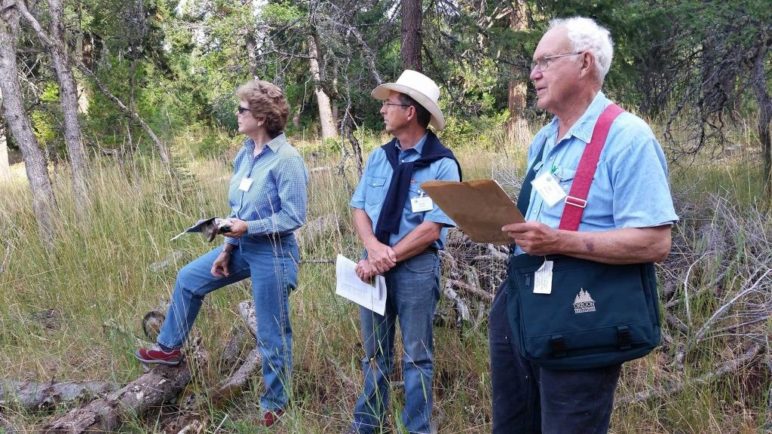
Landowner, Jud Parsons (right); Pacific Forest Trust (PFT) Board Member, Stuart Bewley (middle); and PFT President, Laurie Wayburn (left) tour Mr. Parsons’s Mountcrest Forest property, protected by a working forest conservation easement. Photo Credit: PFT Staff
For a landowner, selling an easement generates immediate revenue while allowing continued use of the land. An ecological WFCE usually costs about half the market price of buying the land outright. In today’s timberland market, this could easily be $1,000 to $3,000 per acre. And forestland with development potential would be more expensive.
That amounts to a lot of money, but it can be a very good deal. The break-even cost of paying industrial forest owners to delay logging for a contract period of 40 years can quickly approach the cost of buying long rotations in perpetuity or even just buying the land. For example, the Pacific Forest Trust recently orchestrated the purchase of a perpetual easement worth about $1,900 per acre on the Mountcrest Working Forest near Ashland, Oregon. For comparison, according to their own calculations, it may cost Port Blakely over $6,000 per acre, in net present value, to delay harvest by 20 years as part of its Winston Creek Forest Carbon Project. Paying upfront for a WFCE is cheaper because the public doesn’t discount the future benefits of protecting our ecosystems and our climate nearly as steeply as the market discounts future harvest revenue. Plus, land will only get more expensive, so now is a good time to buy WFCEs.
But is there funding to pay for WFCEs? In short, not even close. Funding long-rotation conservation easements on all 8 million acres of western Oregon and Washington forests currently logged on short rotations would cost on the order of $16 billion.3 And that’s not considering the higher prices for timberland at risk of development.
WFCEs are funded by a diverse array of local, state, philanthropic, and “transfer of development rights” programs. The single largest funding source is the United States Department of Agriculture (USDA) Forest Legacy Program (FLP), which funds WFCEs on ecologically valuable land at risk of development. In 2021, Oregon and Washington together received $14.2 million in FLP funding.4 Assuming state matching at 25 percent, this comes to about $18 million. So even if the entire budget focused on extending rotations, current funding levels could only finance easements on about one-tenth of one percent of the timberlands currently logged on short rotations west of the Cascade Mountains.
The beauty of the FLP, though, is that it already exists. No new laws have to be passed. The USDA, Washington DNR, Oregon Department of Forestry, local Forest Service districts, and local land trusts already have experience with FLP. To fund older forests at scale, all that is required are minor modifications to current FLP rules5 and a historic appropriations bill in Congress, which could theoretically happen as early as the 2023 Farm Bill.
2. Expand the Healthy Forests Reserve Program
Protecting forests in perpetuity is both the advantage of WFCEs and also a hurdle for landowners. As Arne Hultgren of Roseburg Resources cautioned, easements do reduce an owner’s options. “It’s like getting married,” he said. “You give up certain things but you gain certain things.”
For timberland owners not ready to say “I do” forever, could federal incentive payments that induce landowners to delay their harvest by 20 or 40 years be effective? This would essentially be renting an extended rotation: storing carbon for a contractual period, after which the owner is free to develop the land or return to short rotations (both of which would release the extra carbon stored during the contract period back to the atmosphere), or they could sign up for another contract period once the initial one ends.
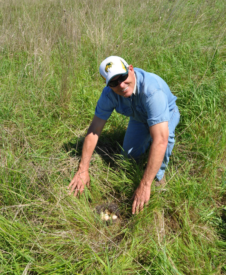
Bruce Pantzke’s CRP-enrolled land enhances pollinator habitat and provides nesting cover for upland game and waterfowl. Source: USDA photostream.
This is the basic model of USDA’s long-standing and well-funded Conservation Reserve Program (CRP). Started in the 1950s to prevent erosion and protect native habitat, the CRP now pays farmers on 10- to 15-year contracts to remove marginal farmland from production. In 2022 about 25.5 million acres are enrolled in CRP across the United States. For timberlands, the CRP counterpart is the much smaller and unevenly implemented USDA Healthy Forests Reserve Program (HFRP).
Farmers that enroll in CRP receive an annual per-acre payment ranging from $10 per acre to nearly $300 per acre. In Lewis County, Washington, for example, the 2020 CRP payment was $64 per acre. Total CRP payments to farmers in Oregon and Washington average about $120 million each year (or $4.8 billion over 40 years). If an equal amount went to the HFRP, forests could live an extra 40 years on somewhere around 10 percent of timberlands that are currently managed on short rotations.
It is an unresolved question just how effective such a program would be at changing forest owners’ logging plans as opposed to mainly attracting forest owners who weren’t planning to log anyway. Plus, as with carbon markets, the public would need to keep paying landowners for short-term carbon storage in perpetuity in order to maintain the climate gains. As a result, this short-term rental approach may do more harm than good by diverting money and political will away from more long-lasting and cost-effective investments.
3. Establish long rotation certification
We’ve heard that we can “vote with our forks,” but can we “vote with our hammers”? A growing movement is saying we can. The idea is that if we are troubled by the timber sector’s practices, we can change the system by spending our dollars on wood products that align with our values.
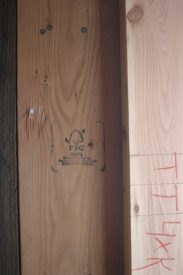
FSC-certified. Source: Giles Douglas
This is only possible if products that meet our values exist and if we can identify them. With the plethora of food labels today (local, grass-fed, organic, humanely raised, and so on), it is hard to remember a time when food was just food.
In the timber sector, groups like the Forest Stewardship Council® (FSC) are trying to chip away at the notion that “wood is wood.” The idea is that certification can change how commercial forestry is practiced by giving consumers the information they need to vote with their dollars. When you see the FSC label on a package of toilet paper or a bin of Douglas-fir boards, you know the forests of origin were managed sustainably (for example, without herbicides). To recoup the extra cost of FSC practices, landowners would need to receive a premium of around 3 to 10 percent.
Like the food sector, wood products could host a variety of labels to differentiate the ways wood products meet our values. “Long Rotation-Certified” or “Older Forest-Certified” could be one of them. Long rotations could fill a small niche left vacant by FSC because they are more profitable for landowners and can store more carbon than FSC-certified timberlands, giving them a high carbon-per-dollar value. (This is not to discount the fact that FSC-certified forests are older and store substantially more carbon than conventional timberlands due to healthy forest practices like greater green tree retention and riparian buffers.)
As far as accomplishing industry-wide transformations, voting with your hammer will suffer from the same inherent shortcomings as voting with your fork: Prices (not ethics) will continue to drive wood purchases. Just as a “farm fresh” or “all-natural” label on a carton of eggs literally means nothing, it will be difficult for customers to differentiate “long rotation-certified” wood from wood that’s simply branded as sustainable. And voting with your hammer may diffuse energy from policy changes that require real votes. Nevertheless, it may be an important component in educating voters to support healthy forest policies at the ballot box.
4. Adopt sustainable wood sourcing policies, both public and private
At the airport in Portland, Oregon (PDX), you can witness another strategy to differentiate sustainable wood products and encourage older forests: sustainable wood sourcing. Not only does the airport’s new roof give the feel of walking through the filtered light of a forest, but its recent remodel also emphasized purchasing Douglas-fir lumber from long-rotation forests. For example, PDX was willing to pay a premium for wood from the Coquille Tribal Forest’s 80- to 100-year rotations.
Sustainable procurement policies set standards for sourcing goods and services that go beyond the typical values of quality, price, and timing. This strategy uses public policies and private initiatives to move markets.
On a daily basis, 55,000 people walk through PDX. By investing in such a public and visible project, Portland is also spreading sustainable wood literacy.

Emulating farm-to-table but applying it to wood, the nonprofit Sustainable Northwest managed the sustainable procurement of more than 2.2 million board feet of wood products for the PDX remodel. That’s about 200 homes’ worth of wood. Large projects like this one have the market muscle to build new supply chains and to advance the transparency of existing ones.
On a daily basis, 55,000 people walk through PDX. By investing in such a public and visible project, Portland is also spreading sustainable wood literacy. According to Sustainable Northwest’s Micah Stanovsky, “People don’t recognize that this thing they’re using comes from a forest, and not all forests are the same.” Travelers passing through PDX learn about sustainable forestry from informative signs and from labels naming the origin of a particular beam or panel. Raising awareness is the first step towards making “voting with your hammer” possible and even towards congressional expansion of the Forest Legacy Program.

The Glulam beams for the wooden roof in PDX’s new terminal were sourced from the FSC-certified Coquille Tribal Forest. Source: USDA, Oregon NRCS (left), PDXNext (right)
With today’s opaque supply chains, the amount of work that goes into sustainable sourcing is astonishing. Aside from FSC-type certifications, today’s supply chains do not differentiate wood products that are produced ecologically, locally, or equitably. To deliver a “sustainable” beam to the customer, a supplier must take unusual efforts to track that wood from the forest and separate out the tracked boards at the mill and possibly a glulam or window manufacturer as well, and then at the warehouse. Plus, investors, developers, architects, and construction engineers all must learn new skills and adapt their designs to work with the different kinds of products (and delivery schedules) that can be procured sustainably. For example, it’s difficult today to find tight-ringed clear cedar, prized for its resistance to water, rot, and insects, that didn’t come from logging Canadian or Alaskan old growth.
The bureaucratic ring of “procurement policies” may not stir excitement, but even without private initiatives, the reach of local, state, and federal government purchasing is staggering. In the United States, state and local governments purchase around $1.5 trillion in goods and services each year, with the federal government adding an additional $665 billion. This is more than 10 percent of US GDP. Presidents Clinton, Bush, Obama, and Biden all issued executive orders for various degrees of sustainable procurement at the federal level, and multiple states have green procurement policies. Imagine the market for long rotation-certified wood if all public procurement policies required sustainably grown wood. This 10 percent could be multiplied if procurement policies extended sustainable sourcing requirements to contracting purchasers, such as for housing construction.
So far, though, neither the federal government nor any state has implemented a sustainable wood sourcing policy. But Portland, Oregon, is leading the way. First, it was a national first-mover in sustainable procurement, and in 2022 it became the first city to explicitly institute a sustainably sourced wood program, following the Sustainable Wood for Cities guidelines.
5. Discipline the forest carbon market
Extending rotations in western Oregon and Washington offers $40 billion worth of climate benefits. Is the global public willing to pay for this carbon sequestration? Could carbon offset markets mainstream long rotations?
The Biden Administration puts the social cost of carbon at $51 per ton of CO2e. (Nobel economist Joseph Stiglitz recommends that the price rise to $100 per ton by 2030.) At 110 tons of additional CO2e stored per acre, extending rotations on 8 million acres of industrial timberland gives you $40 billion.
Unfortunately, as I wrote in a previous article, the carbon market hasn’t caught up, and it probably won’t. In Oregon and Washington, all of the current offset projects combined store less than one million tons of CO2e each year—only about one-tenth of one percent of the additional storage from extending rotations. The carbon market is growing, but will it grow by 1,000 percent?
Plus, the market price for carbon is far too low to spur real change in logging practices. To compensate landowners for the full cost of extending rotations (plus a 20 to 40 percent commission to carbon project developers), the price of carbon needs to be around $58 per ton for a 20-year extension6 and double that for a 40-year extension. But the market price for carbon has hovered around $7.47 per ton in the voluntary market and around $18 to $30 per ton in California’s compliance market. It would take more than a 1,000 percent increase to hit the break-even carbon price needed to attract real change from timber companies.
Fundamentally, carbon market growth is limited by a major free-rider problem. Whether or not one individual does their part and pays for their own emissions essentially has no bearing on the fate of the climate, but it does bear on their own finances. Unless we are required to pay, as some California industries are, most of us won’t (“why should I if nobody else is?”).
The carbon market suffers from other problems as well. Offsets do not always add carbon storage that would not have otherwise happened (the “non-additionality” problem). And offset projects often store carbon for only 40 years, not nearly long enough to compensate for the hundreds or thousands of years carbon emissions linger in the atmosphere (the “impermanence” problem).
The carbon market has helped advocates conserve valuable forest acres. But for the task of extending rotations on commercial timberlands, its efficacy is limited.
6. Explore “impact investing” opportunities for long rotations
Conventional timber investment funds make money from selling trees and land that have appreciated in value. As a group, timber investment management organizations (TIMOs) have been vilified for accelerating the contraction in rotation age and generally degrading forest health and community wealth.
But there is a new type of timber investor on the block that is bringing private equity capital into the conservation neighborhood. The mission of forestry “impact investors” is to generate a financial return while measurably restoring forest health.
As a financial asset, timber offers predictable cash flows, “countercyclical” returns that tend not to rise and fall with the market, and a hedge against inflation. Impact investors also hope to capture value from selling non-timber ecological services that are becoming more fully monetized, such as water, habitat, aesthetics, recreation, and carbon values. Along with selling timber and carbon offsets, revenue comes from leasing use rights to hunting and fishing groups, selling non-timber forest products such as forest-foraged berries, and selling conservation easements (often paid for by government and philanthropic grants).
In Cascadia, EFM Investments & Advisory (formerly Ecotrust Forest Management) has been an early innovator in the impact forestry sector. EFM is a for-profit TIMO that is restoring forests and practicing FSC-certified timber production on the roughly 130,000 acres it owns and manages in California, Oregon, and Washington. “Rotation” is one of EFM’s ”5Rs™ of climate-smart forestry,” along with retention, reserves, resilience, and relationships, which together result in older forests and double the carbon storage compared with industrially managed forests.
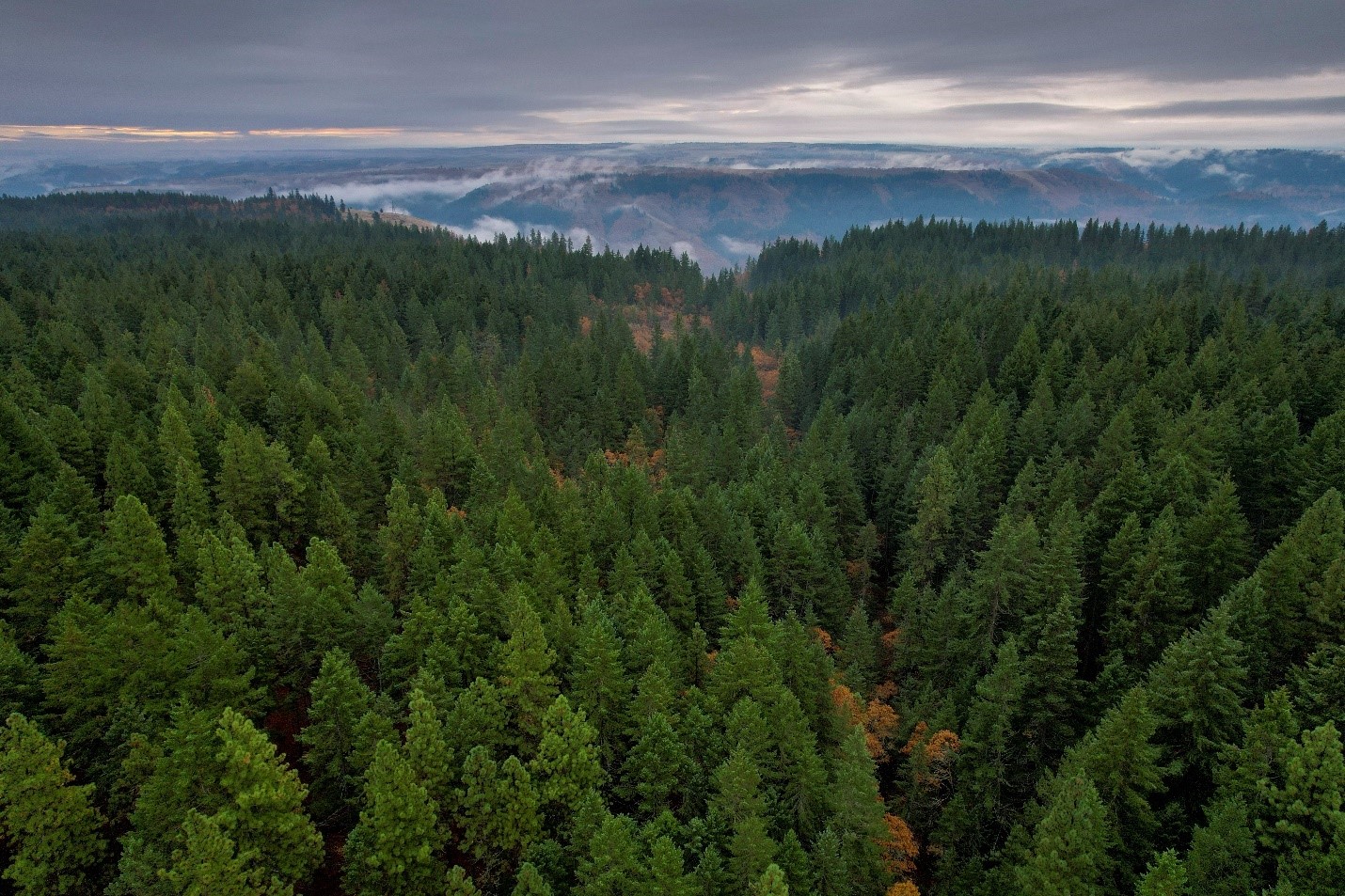
Former SDS Lands, outside Trout Lake, WA now protected under working forest conservation easements and managed by Green Diamond Resource Company. @ianshivephoto / @tandemstock
Also in Cascadia, The Conservation Fund, a nonprofit impact forestry asset manager, recently facilitated the purchase and permanent conservation of more than 96,000 acres of ecologically valuable lands near the Oregon–Washington border about an hour east of Portland. Regional conservationists were alarmed when the SDS Lumber Company announced the land sale. Without the impact investment capital previously raised from selling more than $100 million in “green bonds,” an industrial timber company would almost certainly have purchased these highly productive timberlands close to Portland and several growing towns, heavily logged them, and eventually sold them for development.
Part of the deal involved purchasing WFCEs on 61,000 commercial acres managed by Green Diamond Resource Company. Project developers say they likely will not pursue carbon offset funding. Had the market price of carbon been higher, these easements might have additionally specified long-rotation forestry in order to qualify as carbon offsets. As it stands, Green Diamond is free to log on short rotations.
Not all “impact funds” are equally virtuous. Many funds, across sectors, not only yield lower financial returns but also often have worse than average social and environmental impacts. It is hard for investors who are not sustainable forestry experts to distinguish funds that restore forests from those managed by charlatans or by ethical managers who still believe wood is wood.
Ultimately, how much impact “impact investors” will have largely depends on the public’s investment. Timber and land are still the main sources of revenue for impact forest investors. To capture income from clean water, wildlife habitat, carbon, or aesthetics, those investors largely rely on the government programs or private philanthropy that many worthy projects covet.
7. Pursue carbon storage through re-localizing forest ownership
One last “buying long rotations” idea is more of a thought experiment at this point, although the agencies and policy infrastructure to implement it are already in place—they have been ready to go since the Dust Bowl.
The Coast Range Association (CRA) took on the challenge of how to achieve an increase in forest carbon storage that responds to the severity of the climate emergency while supporting local economies in forested rural Oregon. The solution hinges on CRA’s (and many others’) analysis that carbon storage (and forest management more broadly) is largely driven by who owns the forests. For the majority of investor-owned timber companies, timberland is an “asset” that delivers “return.” The ratio of asset value to return drives the timber enterprise. It turns out that a low-carbon plantation forest delivers the best ratio of asset value to return.
The CRA reasons that state-sponsored market incentives or outright regulation are politically infeasible in Oregon and a carbon transition could harm forestry workers. But buying private industrial timberlands at fair market value could avoid political resistance from the timber sector and redirect cash flow into local economies.
In CRA’s vision, locally owned social benefit enterprises that agree to increase forest carbon through a WFCE would qualify for a mix of federal grants and low- or no-interest loans to buy timberlands. In this way, land ownership would be re-localized in the hands of rural Oregonians, and forests would store more carbon.
In today’s political climate, though, CRA’s proposal is a long shot. Chuck Willer, CRA’s director, admits that “implementing the CRA proposal depends on a national mobilization.” But pushing boundaries has always been vital for progress; after all, it was Einstein’s “elevator thought experiment” that freed him from the scientific limitations of the time, leading to his crowning theory of gravity. As Willer noted, “if we had a national mobilization, we should be prepared with a proposal to respond adequately to it.”
Even without a national mobilization, CRA’s proposal offers some guideposts. It takes as its starting point the full problem to be solved. It takes the unusual step of jointly addressing climate and rural economic justice. And it proposes a solution that directly addresses the underlying drivers of the low-carbon private forest: investor-driven forest management.
The seedlings of long rotation change
The first step to growing long rotations is understanding the roots of the problem: In today’s system, timber companies don’t have to pay the climate and ecological costs of short rotations. And, as public goods that all can enjoy whether or not we pay, there will never be adequate voluntary funding to pay for the benefits of long rotations.
Fixing the short-rotation market failure is both worth it—at roughly a 100 percent return on investment—and possible, if not easy. The first step is raising awareness that some ways of growing trees deliver a lot more value than others (updating the “wood is wood” narrative). Loud grassroots advocacy is important. But so are market tools that connect directly with the public, such as PDX’s educational and visible sustainable wood sourcing remodel project or certification labels like FSC or “long rotation-certified.”
Ultimately, though, by acting individually in atomistic markets (i.e., voting with their hammers or their carbon dollars), the people who could benefit from long rotations on the roughly eight million acres of private industrial forest in Oregon and Washington simply cannot muster sufficient funds to pay, because these market solutions to the short-rotation market failure suffer their own market failures. Only by joining together and casting votes for elected officials who will invest public dollars in long rotations can we solve the short-rotation market failure.
Luckily, the public programs are already in place to fully pay landowners their cost to delay harvest. What’s needed are a few modifications to the federal Forest Legacy Program and the Healthy Forest Reserve Program and a sufficient appropriations bill to scale these programs.
Public dollars would stretch further if they were coupled with tools that directly addressed the negative externalities of short rotations. In a future article, I will explore modifications to the tax code, policy protections, and other tools that require timber companies to shoulder some of the ecological burden of short-rotation forestry—and level the playing field for those that already do.

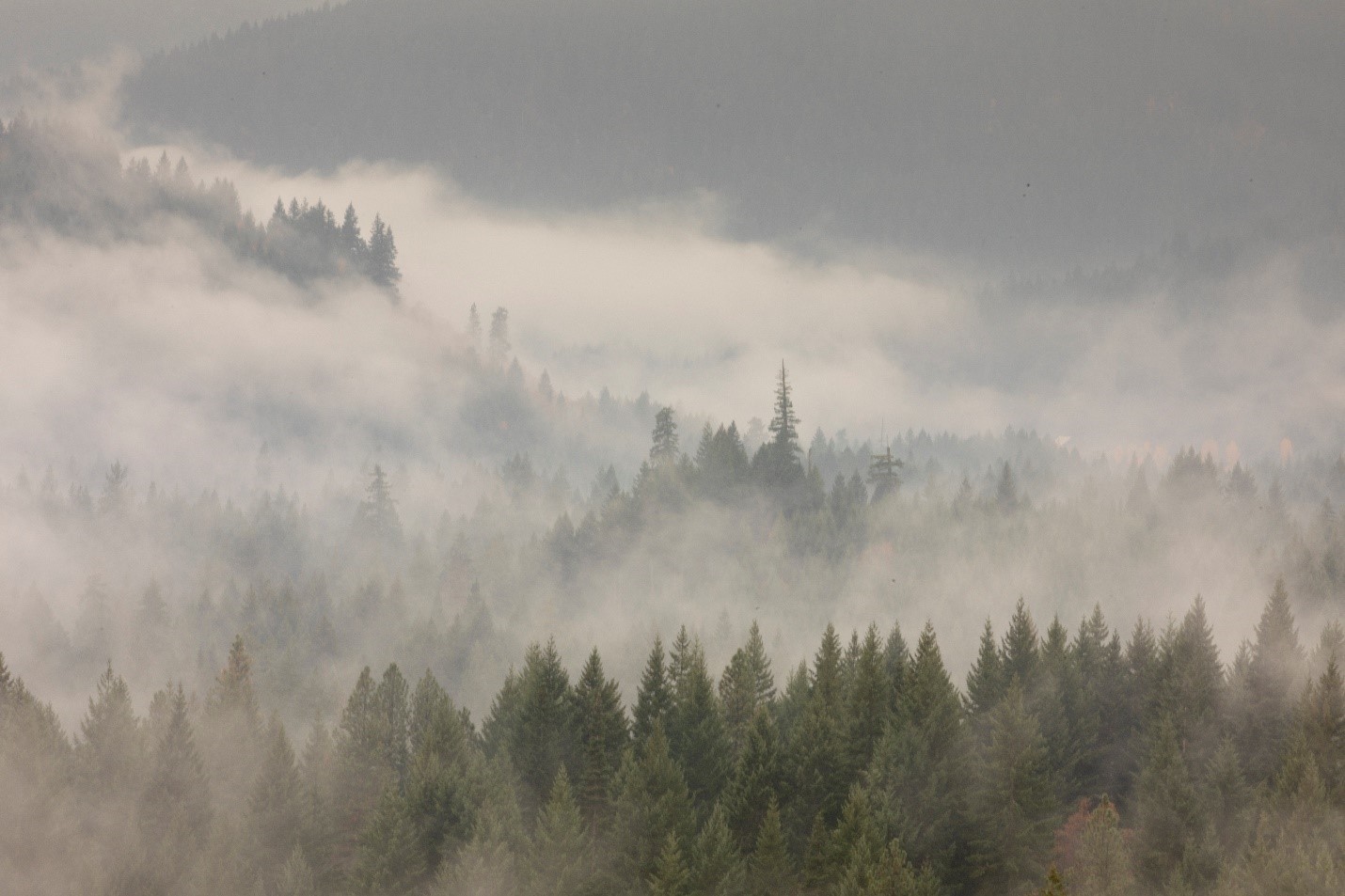
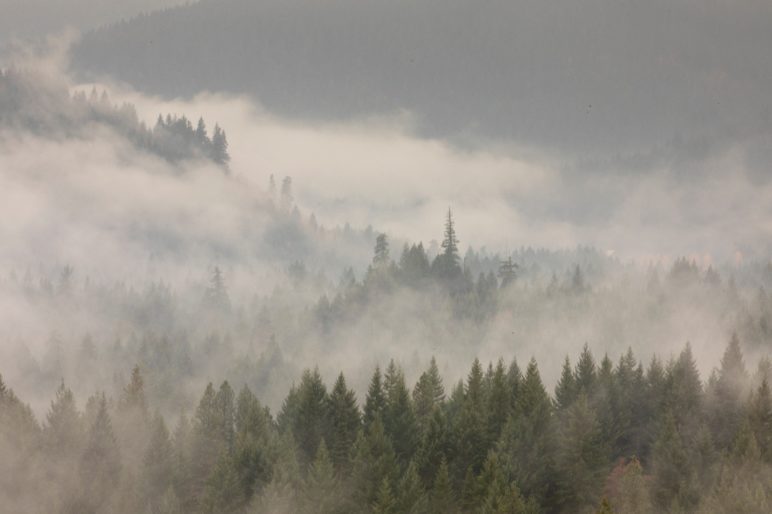
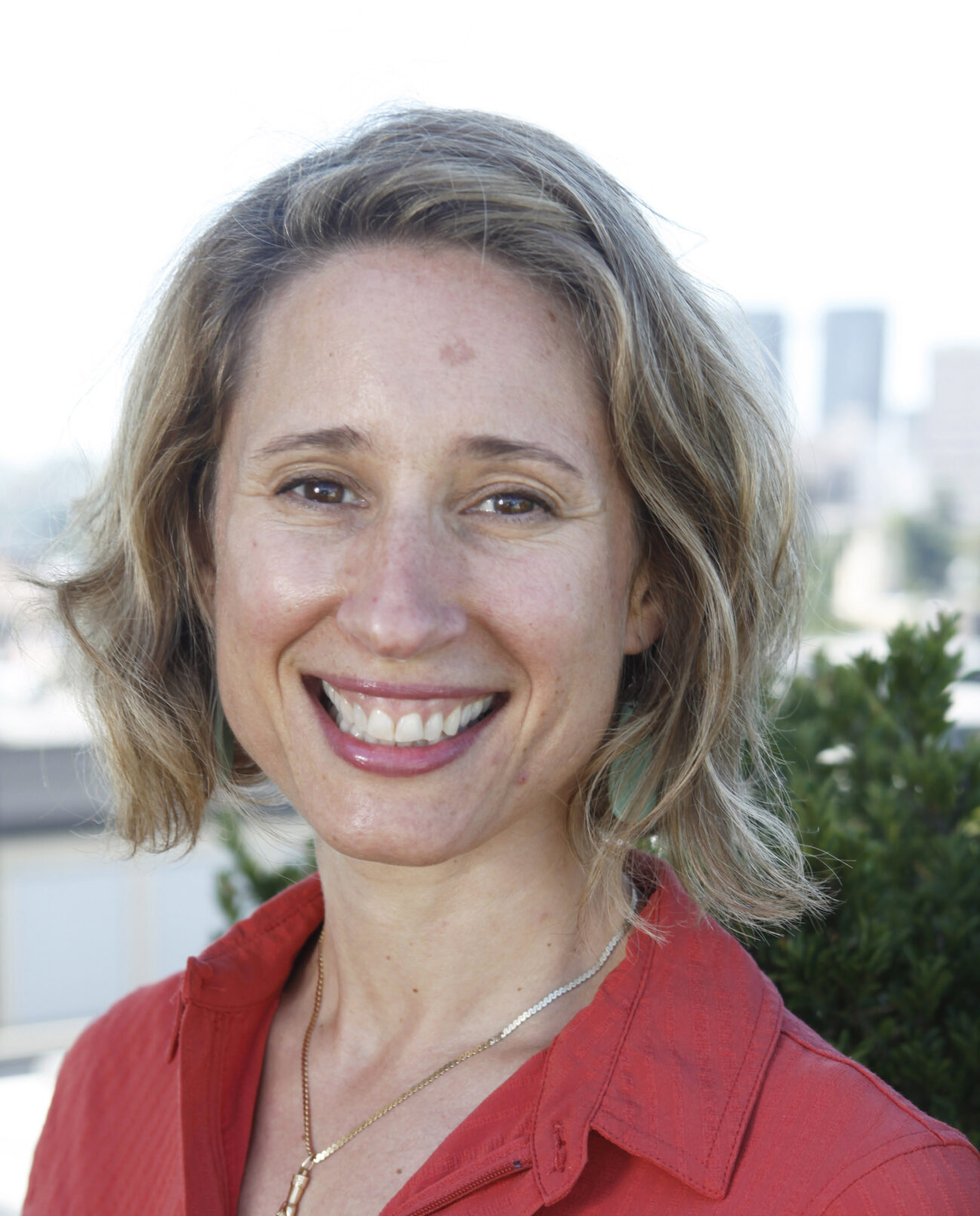

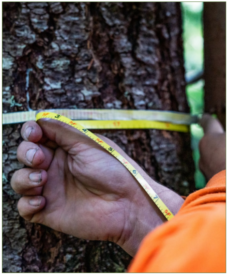
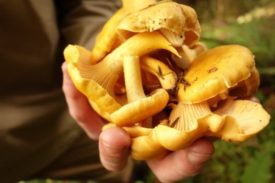
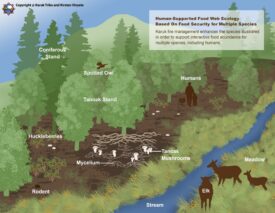
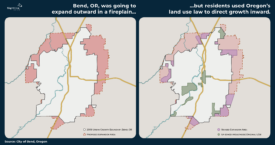

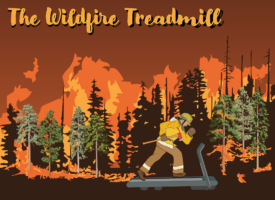
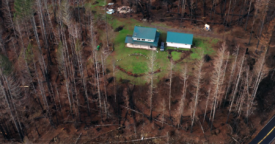

David Moore
In the driest forest like eastern WA we may need short rotation but leaving the biggest and most drought tolerant uncut like ponderosa pines and some big doug firs.
Gifford Pinchot III
I presume you are thinking of wildfire threats meaning that less fuel intense stands are needed. “Ponderosa pines” triggered a concern. Most of the west’s mega fires take place in ponderosa pine forests. Is that because ponderosa pine is fire prone or because that species is located where it is dry, or both? I’ll find out.
Jonathan Shakes
Regarding this estimate:
“$16 billion is a rough estimate of the cost to purchase a working forest conservation easement that specifies older forests, typically between $1,000 to $3,000 per acre, on all 8 million industrial acres.”
That assumes the price per acre remains the same. If we took this approach at a large scale and the number of industrial acres started to decline, would the smaller level of supply make the easement cost per acre go up significantly?
Kate Anderson
Hi Jonathan, You raise an important point: what would the feedback and equilibrium effects be of any change in ownership, prices, policies…?
Once a substantial acreage was protected with easements, I imagine, quite a few things would change, depending on the nature of that process.
By homing in on $16 billion (and our other ball-park numbers), our intention was to ground the conversation in concrete magnitudes, as a first pass. To set the initial parameters for exactly this kind of question and for more sophisticated analyses.
If enough acres committed to long rotations all at the same time, depending on substitute supply sources (e.g., state & fed lands, although I wouldn’t weigh in on that at this point), timber prices would likely go up, which would raise the price of any easements that delay harvest. (It might also drive down the rotation age on non-encumbered acres, where biologically practical.) Additionally, depending on growth laws, a relative scarcity of developable land would increase the speculative component of the price of unencumbered land and the cost of easements.
On the other hand, if we can get over the supply dip, which I’ll explore in a future article, then eventually there will be a higher equilibrium volume of timber from private timberlands, due to long rotations. All else being equal (which of course it won’t be), timber prices would slide back down.
Thank you for bringing this up.
Gifford Pinchot III
Kate,
I notice that you don’t talk about fire, perhaps because wildfire is less frequent west of the Cascades. But fire intervals west of the Cascades are shortening. And best practices west of the Cascades are evolving rapidly. How does all that play into your calculations.
Chuck Willer
The strategy of paying a firm to extend rotation misses a key consideration – that of acquiring the firm.
In 2016, Plum Creek Timber Company was bought by the Weyerhaeuser Company.
Plum Creek owned approximately 6.2 million acres of timberlands located over 19 states. Weyerhaeuser paid $8.4 billion to acquire Plum Creek. This is about $1,355 per acre of timberland or $1,668 in today’s dollars.
Currently (2/08/2023), Weyerhaeuser’s market capitalization stands at $34.16 billion. Offering a 30% stock premium for an acquisition purchase means that for a bit over $22 billion (50%+ of shares @ a 30% premium) a takeover of Weyerhaeuser might occur. Such control gives the takeover group a leading company for manufacturing lumber and other wood products, extensive domestic and foreign marketing channels and 12.4 million acres of U.S. timberland and 14 million acres of licensed Crown lands in Canada. With the stated intention of gaining control of the company and ending its REIT status, stock value would likely decline and eventual control may occur at a substantially lower takeover cost than a 30% share premium.